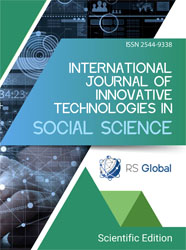MYOPIA – EPIDEMIOLOGY AND MANAGEMENT IN THE PEDIATRIC POPULATION
Abstract
Introduction and Purpose: Myopia is currently the most prevalent refractive error worldwide, with a rapidly increasing incidence, particularly among children and adolescents in urbanized regions. This review outlines the most effective evidence-based strategies for preventing and slowing the progression of myopia, with a focus on both pharmacological and non-pharmacological approaches.
The State of Knowledge: Recent studies have highlighted that increased time spent outdoors significantly reduces the onset of myopia in non-myopic children, though its effect on progression in already myopic individuals appears limited. Light exposure, especially to moderate-intensity natural light, has shown potential in mitigating axial elongation and promoting choroidal thickening. Sleep quality and duration may also influence myopia development, though further research is needed to confirm this relationship. Pharmacological intervention with low-dose atropine (particularly 0.01–0.05%) is currently the most effective and widely accepted treatment, offering substantial benefits with minimal side effects. Optical interventions such as orthokeratology, multifocal spectacle lenses, and dual-focus contact lenses have demonstrated efficacy in controlling axial elongation by modifying peripheral retinal defocus.
Summary: Combining lifestyle modifications (outdoor activity and light exposure) with pharmacological (low-dose atropine) and optical (e.g., orthokeratology and bifocal lenses) interventions provides a comprehensive, multimodal strategy to manage and slow myopia progression. Early implementation of such interventions is essential in addressing the growing public health burden of myopia.
References
Baird, P.N., et al., Myopia. Nat Rev Dis Primers, 2020. 6(1): p. 99.
Han, X., et al., Myopia prediction: a systematic review. Eye (Lond), 2022. 36(5): p. 921-929.
Chamberlain, P., et al., Axial length targets for myopia control. Ophthalmic Physiol Opt, 2021. 41(3): p. 523-531.
Du, R., et al., Continued Increase of Axial Length and Its Risk Factors in Adults With High Myopia. JAMA Ophthalmol, 2021. 139(10): p. 1096-1103.
Yang, K., et al., Comparison of pre-chop technique using a reverse chopper and classic stop-and-chop technique in the treatment of high myopia associated with nuclear cataract. BMC Surg, 2022. 22(1): p. 206.
Chen, Y., et al., Identifying Children at Risk of High Myopia Using Population Centile Curves of Refraction. PLoS One, 2016. 11(12): p. e0167642.
Ohno-Matsui, K., et al., IMI Pathologic Myopia. Invest Ophthalmol Vis Sci, 2021. 62(5): p. 5.
Wong, T.Y., et al., Epidemiology and disease burden of pathologic myopia and myopic choroidal neovascularization: an evidence-based systematic review. Am J Ophthalmol, 2014. 157(1): p. 9-25.e12.
Holden, B.A., et al., Global Prevalence of Myopia and High Myopia and Temporal Trends from 2000 through 2050. Ophthalmology, 2016. 123(5): p. 1036-42.
Jonas, J.B., et al., IMI Prevention of Myopia and Its Progression. Invest Ophthalmol Vis Sci, 2021. 62(5): p. 6.
Guggenheim, J.A., et al., Time outdoors and physical activity as predictors of incident myopia in childhood: a prospective cohort study. Invest Ophthalmol Vis Sci, 2012. 53(6): p. 2856-65.
Sherwin, J.C., et al., The association between time spent outdoors and myopia in children and adolescents: a systematic review and meta-analysis. Ophthalmology, 2012. 119(10): p. 2141-51.
Xiong, S., et al., Time spent in outdoor activities in relation to myopia prevention and control: a meta-analysis and systematic review. Acta Ophthalmol, 2017. 95(6): p. 551-566.
Guo, Y., et al., Outdoor Jogging and Myopia Progression in School Children From Rural Beijing: The Beijing Children Eye Study. Transl Vis Sci Technol, 2019. 8(3): p. 2.
Biswas, S., et al., The influence of the environment and lifestyle on myopia. J Physiol Anthropol, 2024. 43(1): p. 7.
Read, S.A., et al., Longitudinal changes in choroidal thickness and eye growth in childhood. Invest Ophthalmol Vis Sci, 2015. 56(5): p. 3103-12.
Chakraborty, R., et al., Effects of mild- and moderate-intensity illumination on short-term axial length and choroidal thickness changes in young adults. Ophthalmic Physiol Opt, 2022. 42(4): p. 762-772.
Read, S.A., et al., Daily morning light therapy is associated with an increase in choroidal thickness in healthy young adults. Sci Rep, 2018. 8(1): p. 8200.
Cohen, Y., et al., Light Intensity in Nursery Schools: A Possible Factor in Refractive Development. Asia Pac J Ophthalmol (Phila), 2022. 11(1): p. 66-71.
Hua, W.J., et al., Elevated light levels in schools have a protective effect on myopia. Ophthalmic Physiol Opt, 2015. 35(3): p. 252-62.
Liu, X.N., T.J. Naduvilath, and P.R. Sankaridurg, Myopia and sleep in children-a systematic review. Sleep, 2023. 46(11).
Agyekum, S., et al., Cost-Effectiveness Analysis of Myopia Progression Interventions in Children. JAMA Netw Open, 2023. 6(11): p. e2340986.
Yam, J.C., et al., Low-Concentration Atropine for Myopia Progression (LAMP) Study: A Randomized, Double-Blinded, Placebo-Controlled Trial of 0.05%, 0.025%, and 0.01% Atropine Eye Drops in Myopia Control. Ophthalmology, 2019. 126(1): p. 113-124.
Simonaviciute, D., et al., The Effectiveness and Tolerability of Atropine Eye Drops for Myopia Control in Non-Asian Regions. J Clin Med, 2023. 12(6).
Tan, D., et al., Topical Atropine in the Control of Myopia. Asia Pac J Ophthalmol (Phila), 2016. 5(6): p. 424-428.
Landreneau, J.R., N.P. Hesemann, and M.A. Cardonell, Review on the Myopia Pandemic: Epidemiology, Risk Factors, and Prevention. Mo Med, 2021. 118(2): p. 156-163.
Gong, Q., et al., Efficacy and Adverse Effects of Atropine in Childhood Myopia: A Meta-analysis. JAMA Ophthalmol, 2017. 135(6): p. 624-630.
Walline, J.J., et al., Interventions to slow progression of myopia in children. Cochrane Database Syst Rev, 2020. 1(1): p. Cd004916.
Logan, N.S. and J.S. Wolffsohn, Role of un-correction, under-correction and over-correction of myopia as a strategy for slowing myopic progression. Clin Exp Optom, 2020. 103(2): p. 133-137.
Chen, M., et al., Myopia Control With Multifocal Lens in School-Aged Children: A Meta-Analysis. Front Pediatr, 2022. 10: p. 889243.
Bullimore, M.A. and L.A. Johnson, Overnight orthokeratology. Cont Lens Anterior Eye, 2020. 43(4): p. 322-332.
Hiraoka, T., et al., Long-term effect of overnight orthokeratology on axial length elongation in childhood myopia: a 5-year follow-up study. Invest Ophthalmol Vis Sci, 2012. 53(7): p. 3913-9.
Tsai, H.R., et al., Efficacy of atropine, orthokeratology, and combined atropine with orthokeratology for childhood myopia: A systematic review and network meta-analysis. J Formos Med Assoc, 2022. 121(12): p. 2490-2500.
Lipson, M.J., The Role of Orthokeratology in Myopia Management. Eye Contact Lens, 2022. 48(5): p. 189-193.
Tang, K., et al., Orthokeratology for Slowing Myopia Progression in Children: A Systematic Review and Meta-Analysis of Randomized Controlled Trials. Eye Contact Lens, 2023. 49(9): p. 404-410.
Li, X., et al., Orthokeratology in controlling myopia of children: a meta-analysis of randomized controlled trials. BMC Ophthalmol, 2023. 23(1): p. 441.
Views:
58
Downloads:
22
Copyright (c) 2025 Sebastian Kupisiak, Aneta Rostkowska, Malwina Draim, Natalia Pasierb, Michalina Kosowska, Wiktoria Dzierzgowska, Aleksandra Sowa, Kacper Trząsalski

This work is licensed under a Creative Commons Attribution 4.0 International License.
All articles are published in open-access and licensed under a Creative Commons Attribution 4.0 International License (CC BY 4.0). Hence, authors retain copyright to the content of the articles.
CC BY 4.0 License allows content to be copied, adapted, displayed, distributed, re-published or otherwise re-used for any purpose including for adaptation and commercial use provided the content is attributed.















